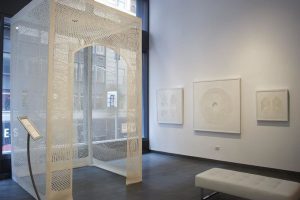Huffington Post
Magnificent Installation in Times Square Lobby
Written by: Isa Freeling
September 16, 2016
An artist with a penchant for paper, Tahiti Pehrson spent fifteen hours a day for three and a half months to create his fantastic installation of Kaleidoscopic systems for his site specific meditations in the lobbies of Viacom. I have visited many of their installations and this one is no less enchanting as the rest, though far more contemplative. Made out of durable cotton rag and using a lot of X-ACTO blades, over 11,000 in fact. Tahiti created a very powerful way, forward and backward, of representing the course of life. The entrance is the exit and the exit is the entrance.
He came up with these cyclical routes after he learned of his father’s descent into cancer and the possibility of his incumbent death after his daughters 10th birthday; with his daughter ascending into life and his father on the opposite side of the spectrum, Tahiti stands in the middle as the observer and the documentarian of the journey. These pure white shapes are excellently adapted to his view, reminding us all of our mortality. Though the idea of mortality might be frightening, Tahiti allays anxiety and creates a manifestation of the simultaneity of existence.
Pretty wild stuff for an office building, but since Viacom deals with the alternative universe of all things media, it makes absolute sense and furthermore, it stands as a universal posit which we all seem to hook into. I suppose it is as a sobering a notion as it is a beautiful representation on the theme.
While on one end of the lobby the pieces appear as muralesque panels, testaments to his vision, the other entrance hosts a kind of launching pad or private space for a person to enter and look through the enclosed environment into the open lobby. This feels a little bit like a priest’s confessional or a finite space meant for contemplation where the world continues outside and time stops to observe and feel in quiet contemplation. According to the artist he was inspired by Italian painters and images of religious icons in boxes, so to speak, like the Madonna. For me I see a bit of Byzantium art forms, Islamic flavors in these architectural choices.
Tahiti tells me that the pattern type is called, “Epitrochrid,” or a circle going around another circle. It is quite mathematical though it doesn’t seem to require the prowess of math, as much as observation and skill to develop the work. Repetition of patterns is the device by which he creates his hypnotic installation starting with diamonds and triangle shapes.
According to Tahiti, “Eptrochiod and Epicycloids are the mechanics behind a system called Guilloche. Many are going to go to the spirograph but these patterns go back to Greek and Roman architecture however they are most commonly known as the patterns on currencies throughout the world, as well as a technique to jewel metal surfaces as in watch-faces and in Faberge Eggs. It has been used as practical alchemy by turning a cheaper material into something that refracts light like a jewel or precious cut stone.”
Tahiti also used other Moire patterns “which are a secondary pattern or visual distortion, which comes about when similarly parallel lines are viewed from a distance. The most common example is when you are driving on the freeway and you drive under an overpass with a chain-link arch and you see this strobing kind of grid creating that movement. You can see this in the tower triptych and it reads very similar to the pattern I’m working with adding to the repetition factor.”
Tahiti goes on to explain the Fibonacci series, “which is a naturally occurring pattern in numbers that shows something about the design sense of nature. By adding each consecutive number to the one before it. 1=1+2 1+2=3 2+3=5 and so on. This gives you the sequence 1,2,3,5,8,13,21,34…….
This is a pattern that creates a scaled graduation from small to large ad-infinitum. The towers I used to create the flower shape in the center (it is skewed a bit form enlarging it in tiles) 1 inch circles, next 2 in, 3 in, 5 in, so it creates this graduating flowers pattern, it’s more generally seen as spiral in concentrically graduating sequence.”
All this being said, the work requires extreme concentration and physical involvement. Tahiti cut himself once or twice but after that, the next 20,000 or so scores were a breeze. I went back to look at the work again, I am impressed by the tranquility and beauty of Tahiti Pehrson’s installation. He has truly executed the manifestation of the cycles of life successfully.




